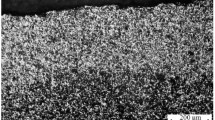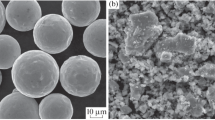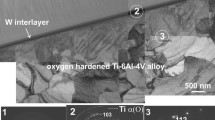The tribological properties of matrix and skeletal titanium carbonitride composites were studied in dry friction conditions in air. Experiments on wetting of the TiCN–Cr3C2 composite by nickel–chromium alloys and copper using the sessile drop method were performed to choose matrix composition and ascertain whether the samples could be produced by impregnation of the porous skeleton. The sessile drop experiments showed that nickel and its alloys formed a low contact angle on the TiCN–Cr3C2 composite (θ ≈ 8°). In particular, Ni3Al intermetallic had θ < 5°, allowing it to be used as a metal matrix. The same situation was observed for copper. A technique was developed for producing TiN–Cr3C2 composites by impregnation of the porous skeleton with Ni3Al and copper melts, and the tribological behavior of the cermets was tested in dry friction conditions. When the starting composite was impregnated with Ni3Al intermetallic, the friction coefficient decreased (μ = = 0.25). Structural studies were conducted with a MIM-10 metallographic microscope and X-ray diffraction with a DRON-2 diffractometer. The hardness and contact area thickness were measured employing a Falcon 9 hardness tester (manufactured in the Netherlands). Thin cross sections were made to examine the structure and phase composition of the contact area. The structure was analyzed using X-ray diffraction and scanning electron microscopy. The effect exerted by hardness of the counterface (steel 45, 40Kh, ShKh15) on the tribological properties of the TiCN–Cr3C2 composite was established. When steel hardness was 60 HRC, the friction coefficient increased with friction distance. These results were, however, obtained at low speeds and loads. Friction losses decreased with loading increasing from 2 to 6 MPa at 12 m/sec: friction coefficient reduced to 0.23. The TiCN–20% Cr3C2 cermets impregnated with Ni3Al may be recommended as antifriction materials for use in high-speed and high-load friction units.











Similar content being viewed by others
References
A.G. Kostornov, A.D. Panasyuk, I.A. Podchernyaeva, A.P. Umanskii, and A.D. Kostenko, “Composite ceramic materials and coatings for tribological use,” Powder Metall. Met. Ceram., 42, No. 5–6, 249–256 (2003).
V.G. Kayuk, V.A. Maslyuk, and A.D. Kostenko, “Tribological properties of hard alloys based on chromium carbide,” Powder Metall. Met. Ceram., 42, No. 5–6, 257–261 (2003).
T.M. Evtushok, A.D. Kostenko, O.N. Grigoriev, G.L. Zhunkovskii, V.A. Kotenko, and P.V. Mazur, “Tribological properties of composite materials based on refractory titanium compounds,” Powder Metall. Met. Ceram., 44, No. 7–8, 353–357 (2005).
T.M. Evtushok, O.M. Grigoriev, O.D. Kostenko, G.L. Zhunkovskii, V.A. Kotenko, and P.V. Mazur, “Composite materials based on titanium nitride for high-speed friction units,” Powder Metall. Met. Ceram., 45, No. 9–10, 445–447 (2006).
Z.B. Jin, N. Liu, B. Zhan, and Q.L. Li, “Influence of WC content on microstructure and mechanical properties of ultrafine TiCN-based cermet,” Cemented Carbide, 27, 269–273 (2010).
C.X. He, X.H. Xia, Y.M. Wang, B.L. Zhao, Q. Tang, and C.H. Mao, “Study of TiCN-based metal ceramic,” Chin. J. Rare Met., No. 23:4, 12 (1999).
F. Monteverde, V. Medri, and A. Bellosi, “Processing and properties of zirconium diboride-based composites,” J. Eur. Ceram. Soc., 22, 415–421 (2002).
J. Jung and S. Kang, “Effect of ultrafine powders on the microstructure of Ti(CN)–xWC–Ni cermets,” Acta Mater., 52, 1379–1386 (2004).
S.-Y. Ahn, S.-W. Kim, and S. Kang, “Microstructure of Ti(CN)–WC–NbC–Ni cermets,” J. Am. Ceram. Soc., 84, 843–849 (2001).
F. Qi and S. Knag, “A study on microstructural changes in Ti(CN)–NbC–Ni cermets,” Mater. Sci. Eng. A, 251, 276–285 (1998).
E.T. Jeon, J. Joardar, and S. Kang, “Microstructure and tribo-mechanical properties of ultrafine Ti(CN) cermets,” Int. J. Refract. Met. Hard Mater., 20, 207–211 (2002).
J. Joardar, S.W. Kim, and S. Kang, “Effect of nanocrystalline binder on the microstructure and mechanical properties of ultrafine Ti(CN) cermets,” Mater. Sci. Eng. A, 360, 385–389 (2003).
D. Mari, S. Bolognini, G. Feusier, T. Cutard, T. Viatte, and W. Benoit, “TiMoCN based cermets. Part II. Microstructure and room temperature mechanical properties,” Int. J. Refract. Met. Hard Mater., 21, 47–53 (2003).
S.-Y. Ahn and S. Kang, “Formation of core/rim structures in Ti(C, N)–WC–Ni cermets via a dissolution and precipitation process,” J. Am. Ceram. Soc., 83, No. 6, 1489–1494 (2000).
A. Chavanes, E. Pauty, and M. Woydt, “Titanium–molybdenum carbonitride as light-weight and wear resistant monolithic material,” Wear, 256, No. 7–8, 647–656 (2004).
Jakob Kübarsepp, Heinrich Klaasen, and Jüri Pirso, “Behavior of TiC-based cermets in different wear conditions,” Wear, 249, No. 3–4, 229–234 (2001).
Heinrich Reshetnyak and Jakob Kübarsepp, “Structure sensitivity of wear resistance of hardmetals,” Int. J. Refract. Met. Hard Mater., 15, 89–95 (1997).
M. Woydt, A. Skopp, I. Dorfel, and K. Witke, “Wear engineering oxides/antiwear oxide,” Tribol. Trans., 42, 21–28 (1999).
V.G. Kayuk and V.A. Maslyuk, “Structure formation in alloys of the Cr3C2–TiN system and the properties of materials based on them,” Powder Metall. Met. Ceram., 43, No. 1–2, 39–43 (2004).
V.G. Kayuk, A.D. Panasyuk, and O.M. Grigoriev, “Reactions of Cr3C2–TiN system materials with nickel–chromium alloys,” Powder Metall. Met. Ceram., 45, No. 7–8, 365–370 (2006).
Author information
Authors and Affiliations
Corresponding author
Additional information
Translated from Poroshkova Metallurgiya, Vol. 59, Nos. 9–10 (535), pp. 57–67, 2020.
Rights and permissions
About this article
Cite this article
Grigoriev, O.N., Mazur, P.V., Neshpor, I.P. et al. Wear-Resistant TiCN-Based Ceramic Materials for High-Load Friction Units. Powder Metall Met Ceram 59, 528–536 (2021). https://doi.org/10.1007/s11106-021-00194-5
Received:
Published:
Issue Date:
DOI: https://doi.org/10.1007/s11106-021-00194-5




